List of Delaware River tributaries
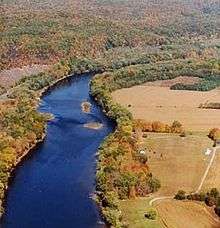
The watershed of the Delaware River drains an area of 14,119 square miles (36,570 km2) and encompasses 42 counties and 838 municipalities in five U.S. states—New York, New Jersey, Pennsylvania, Maryland, and Delaware.[1]:p.9 This total area constitutes approximately 0.4% of the land mass in the United States.[1]:p.9 The Delaware River rises in New York's Catskill Mountains flowing southward for 419 miles (674 km) into Delaware Bay where its waters enter the Atlantic Ocean near Cape May in New Jersey and Cape Henlopen in Delaware. There are 216 tributary streams and creeks—an estimated 14,057 miles of streams and creeks—in the watershed.[1]:p.11,25
The waters of the Delaware River's basin are used to sustain "fishing, transportation, power, cooling, recreation, and other industrial and residential purposes."[1]:p.9 While the watershed is home to 4.17 million people according to the 2000 Federal Census, these bodies of water provide drinking water to 17 million people—roughly 10% of the population of the United States.[1]:p.vi,9 It is the 33rd largest river in the United States in terms of flow, but the nation's most heavily used rivers in daily volume of tonnage.[1]:p.11 The average annual flow rate of the Delaware is 11,700 cubic feet per second at Trenton, New Jersey.[1]:p.9
Tributaries of the Delaware River
The main tributaries in New York are the Mongaup and Neversink rivers and Callicoon Creek. From Pennsylvania, the major tributaries are the Lackawaxen, Lehigh, and Schuylkill rivers. From New Jersey, the Big Flatbrook, Pequest, Musconetcong, and Maurice rivers, plus Oldmans, Raccoon and Rancocas creeks, flow into the Delaware.
Tributaries are arranged generally north to south from the source of the river to its mouth, its confluence with the Delaware River, tributaries within that rivers' watershed are mentioned in notes.
Tributaries in New York
- West Branch Delaware River
- Little Delaware River
- East Branch Delaware River
- Beaver Kill
- Willowemoc Creek
- Little Beaver Kill
- Willowemoc Creek
- Tremper Kill
- Beaver Kill
- Callicoon Creek
- East Branch Callicoon Creek
- North Branch Callicoon Creek
- Tenmile River
- Mongaup River
- Black Brook
- West Branch Mongaup River
- Middle Mongaup River
- East Mongaup River
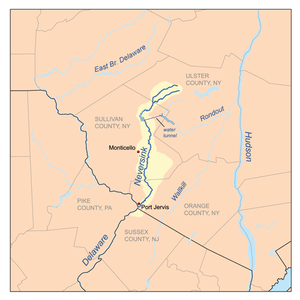 Neversink Drainage Basin
Neversink Drainage Basin
- Neversink River
- Basher Kill
- Sheldrake Stream
- East Branch Neversink River
- West Branch Neversink River
Tributaries in Pennsylvania
- West Branch Delaware River
- Shehawken Creek
- Equinunk Creek
- Lackawaxen River
- Shohola Creek
- Big Bushkill Creek
- Little Bush Kill
- Saw Creek
- Rock Hill Creek
- Sawkill Creek
- Dwarf Kill
- Raymondskill Creek
- Brodhead Creek
- Marshalls Creek
- Pocono Creek
- Paradise Creek
- Levitt Branch
- Middle Branch Brodhead Creek
- Cherry Creek (along the Appalachian Trail)
- Caledonia Creek (along the Appalachian Trail)
- Martins Creek
- Bushkill Creek

- Lehigh River
- Saucon Creek
- Monocacy Creek
- Little Lehigh Creek
- Catasauqua Creek
- Coplay Creek
- Hokendauqua Creek
- Indian Creek
- Trout Creek
- Aquashicola Creek
- Lizard Creek
- Pohopoco Creek
- Mahoning Creek
- Mauch Chunk Creek/White Bear Creek
- Nesquehoning Creek
- Jeans Run
- Black Creek
- Quakake Creek
- Hazle Creek
- Mud Run
- Bear Creek
- Tobyhanna Creek
- Tohickon Creek
- Deep Run
- Biles Creek
- Scotts Creek
- Neshaminy Creek
- Newtown Creek
- Little Neshaminy Creek
- Poquessing Creek
- Pennypack Creek
- Frankford Creek
- Cohocksink Creek
- Cohoquinoque Creek
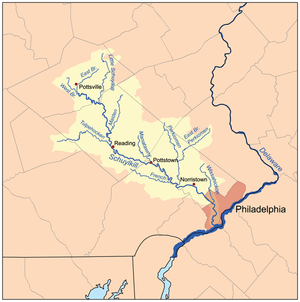
- Schuylkill River
- Mingo Creek (former Cobbs Creek tributary)
- Mill Creek (Philadelphia)
- Wissahickon Creek
- Mill Creek (Montgomery County, Pennsylvania)
- Stoney Creek
- Valley Creek
- Perkiomen Creek
- Skippack Creek
- Towamencin Creek
- East Branch Perkiomen Creek
- Swamp Creek
- Unami Creek
- West Branch Perkiomen Creek
- Hosensack Creek
- Skippack Creek
- Pickering Creek
- French Creek
- Scotts Run
- Pigeon Creek
- Manatawny Creek
- Ironstone Creek
- Little Manatawny Creek
- Monocacy Creek
- Hay Creek
- Antietam Creek
- Allegheny Creek
- Angelica Creek
- Wyomissing Creek
- Tulpehocken Creek
- Cacoosing Creek
- Northkill Creek
- Little Northkill Creek
- Wolf Creek
- Maiden Creek
- Irish Creek
- Little Schuylkill River
- Indian Run
- Panther Creek
- Pine Creek
- West Branch Schuylkill River
- West West Branch Schuylkill River
- West Creek
- West West Branch Schuylkill River
- Norwegian Creek
- Mill Creek (Port Carbon, Pennsylvania)
- Silver Creek
- Darby Creek
- Crum Creek
- Little Crum Creek
- Trout Run
- West Crum Creek
- Ridley Creek
- Vernon Run
- Spring Run
- Dismal Run
- Hunters Run
- Chester Creek
- West Branch Chester Creek
- Goose Creek
- Naamans Creek
- Christina River
- Brandywine Creek
- East Branch Brandywine Creek
- Valley Creek
- West Branch Brandywine Creek
- Buck Run
- Doe Run
- Buck Run
- East Branch Brandywine Creek
- White Clay Creek
- Red Clay Creek
- Mill Creek
- Broad Run
- Walnut Run
- Brandywine Creek
Tributaries in New Jersey
The Appalachian Trail crosses the following tributaries or the watersheds of these tributaries in New Jersey: (1) Flat Brook (Big Flat brook), (Little Flat Brook), Dunnfield Creek, Stony Brook (Shawpocussing Creek), Paulins Kill (via its tributary Yards Creek and Jacksonburg Creek).
- Flat Brook
- Van Campens Creek
- Dunnfield Creek
- Stony Brook (Shawpocussing Creek)
- Paulins Kill
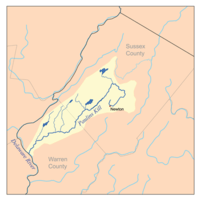 Paulins Kill Drainage Basin
Paulins Kill Drainage Basin - Pequest River
- Lopatcong Creek
- Pohatcong Creek
- Musconetcong River
- Hakihokake Creek
- Harihokake Creek
- Nishisakawick Creek
- Little Nishisakawick Creek
- Lockatong Creek
- Wickecheoke Creek
- Alexauken Creek
- Swan Creek
- Moores Creek
- Fiddlers Creek
- Jacobs Creek
- Assunpink Creek
- Crosswicks Creek
- Assiscunk Creek
- Rancocas Creek
- Pennsauken Creek
- Cooper River
- Big Timber Creek
- Woodbury Creek
- Mantua Creek
- Raccoon Creek
- Oldmans Creek
| Photo | Tributary | River length | Watershed area | Notes and remarks |
|---|---|---|---|---|
| Flat Brook | 11.6-mile-long (18.7 km) |
| ||
 | Paulins Kill | 41.6-mile (66.9 km) | 176.85 square miles (458.0 km2) |
|
| Pequest River | 35.7-mile-long (57.5 km) | 162.62 square miles (421.2 km2) |
| |
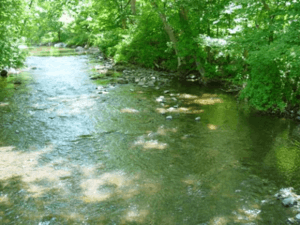 | Musconetcong River | 45.7-mile-long (73.5 km) |
|
Tributaries in Delaware
- Naamans Creek
- South Branch Naamans Creek
- Perkins Run
- Stoney Creek
- Shellpot Creek
- Matson Run
- Turkey Run
- Christina River
- Brandywine Creek
- Alapocas Run
- Husbands Run
- Willow Run
- Wilson Run
- Rocky Run
- Hurricane Run
- Carney Run
- Ramsey Run
- Beaver Creek
- Little Mill Creek
- Chestnut Run
- Willow Run
- Nonesuch Creek
- White Clay Creek
- Hershey Run
- Red Clay Creek
- Hyde Run
- Mill Creek
- Pike Creek
- Middle Run
- Leathermans Run
- Belltown Run
- Muddy Run
- West Branch Christina River
- Persimmon Run
- East Branch Christina River
- Brandywine Creek
Tributaries of Delaware Bay

Delaware Bay is a major estuary outlet of the Delaware River on the Northeast seaboard of the United States whose fresh water mixes for many miles with the waters of the Atlantic Ocean. The bay, as an estuary, forms a transitional zone between the river environment provided by the Delaware River and maritime environment of the Atlantic Ocean that is subject to both marine influences, such as tides, waves, and the influx of saline water; and riverine influences, such as flows of fresh water and sediment. Delaware Bay covers 782 square miles (2,030 km2) in area.[2] The bay is bordered by the State of New Jersey and the State of Delaware. The bay's outermost boundary separating it from the Atlantic are two capes: Cape Henlopen and Cape May.
The shores of the bay are largely composed of salt marshes and mud flats, with only small communities inhabiting the shore of the lower bay. Besides the Delaware, it is fed by numerous smaller streams. Several of the rivers hold protected status for the unique salt marsh wetlands along the shore of the bay. The bay serves as a breeding ground for many aquatic species, including horseshoe crabs. The bay is also a prime oystering ground. The Delaware Bay was designated a Ramsar Wetland of International Importance on May 20, 1992. Further, it was the first site classified in the Western Hemisphere Shorebird Reserve Network.
Tributaries in New Jersey
- Dennis Creek
- East Creek
- West Creek
- Maurice River
- Muskee Creek
- Manumuskin River
- Manantico Creek
- Muddy Run
- Scotland Run
- Still Run
- Dividing Creek
- Fishing Creek
- Fulling Mill Stream
- Oranoaken Creek
- Nantuxent Creek
- Cedar Creek
- Back Creek
- Cohansey River
- Stow Creek
- Alloway Creek
- Salem River
Tributaries in Delaware
- Army Creek
- Tom Creek
- Red Lion Creek
- Doll Run
- Cedar Creek
- Dragon Creek
- Saint Georges Creek
- Scott Run
- Joy Run
- Crystal Run
- Augustine Creek
- Silver Run
- Appoquinimink River
- The Big Ditch
- Hangmans Run
- Drawyer Creek
- Blackbird Creek
- Fishing Creek
- Beaver Branch
- Barlow Branch
- Sandom Branch
- Angle Rod Creek
- Smyrna River
- Sawmill Branch
- Corks Point Ditch
- Morris Branch
- Green Spring Branch
- Massey Branch
- Duck Creek
- Providence Creek
- Paw Paw Branch
- Providence Creek
- Taylors Gut
- Duck Creek
- Quarter Gut
- Hawkey Branch
- Quarter Gut
- Leipsic River
- Raymond Gut
- Dyke Branch
- Bennefield Branch
- Spruances Branch
- Snows Branch
- Alston Branch
- Willis Branch
- Simons River
- Herring Branch
- Green Creek
- Muddy Branch
- Mahon River
- Old Womans Gut
- Little River
- Lewis Ditch
- Sand Ditch
- St. Jones River
- Cypress Branch
- Tidbury Creek
- Isaac Branch
- Puncheon Run
- Fork Branch
- Murderkill River
- Spring Creek
- Double Run
- Hudson Branch
- Pratt Branch
- Ash Gut
- Browns Branch
- Ward Branch
- Spring Branch
- Spring Creek
- Brockonbridge Gut
- Mispillion River
- Fishing Branch
- Swan Creek
- Deep Branch
- Mullet Run
- Bowman Branch
- Lednum Branch
- Johnson Branch
- Tantrough Branch
- Beaverdam Branch
- Cedar Creek
- Slaughter Creek
- Beaverdam Branch
- Church Branch
- Broadkill River
- Canary Creek
- Broadkill Sound
- Primehook Creek
- North Prong
- Sowbridge Branch
- Ingram Branch
- Primehook Creek
- Old Mill Creek
- Fisher Creek
- Black Hog Gut
- Martin Branch
- Crooked Creek
- Doty Glade
- Beaverdam Creek
- Round Pole Branch
- Ingram Branch
- Pemberton Branch
See also
- Delaware River (Kansas)
- Delaware River and Bay Authority
- Delaware River Basin Commission
- Delaware River Joint Toll Bridge Commission
- Delaware River Port Authority
- Delaware Valley (an alternative term for the Philadelphia metropolitan area)
- Delaware Water Gap
- Delaware Water Gap National Recreation Area
- List of crossings of the Delaware River
- List of rivers of Delaware
- List of rivers of Maryland
- List of rivers of New Jersey
- List of rivers of New York
- List of rivers of Pennsylvania
- Tocks Island Dam controversy
References
- 1 2 3 4 5 6 7 Philadelphia Water Department. "Moving from Assessment to Protection...The Delaware River Watershed Source Water Protection Plan" (PWSID #1510001) (June 2007). Retrieved 17 July 2013.
- ↑ Overview of the Delaware River Watershed
External links
- Delaware River and Bay Authority
- Delaware River Basin Commission
- Delaware River Joint Toll Bridge Commission
- Delaware River Port Authority Official Website
- Delaware Riverkeeper Network
- National Park Service: Delaware Water Gap National Recreation Area
- National Park Service: Upper Delaware Scenic & Recreational River
- National Park Service: Lower Delaware Wild & Scenic River